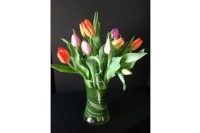How Tulips were treated as money
Tulips were originally found in the central Asian mountainsides of Tien Shan and the Pamir and were first successfully gardened during the Ottoman Empire. Tulip was introduced to the Netherlands in the early phase of the 1600s by the normal trade route and what followed came to be known in history as the Tulpmanie, the Dutch synonym for Tulip Mania. It was the first reported incident of an economic crackdown, ages before the modern day depression or bursting of other economic bubbles.
The Origin of Tulips
The early 17th century saw a rise of an affluent middle-class gentry in the Netherlands. Tulips, being new to the European markets at that point in time, quickly caught the fancy of the Dutch middle class. Dutch botanists engaged themselves in the rat race of crossbreeding different varieties known as “cultivars”. These cultivars began to be exchanged within the network of scholars. The network seems to be ever-growing until the time came when it was not limited to known acquaintances.
Know the History
It all happened during the winter months of 1636 to 1637, when tulip bulbs, which require 10 to 12 years to bloom, were dormant, and the flowers cannot be traded in physical form. The trading actually happened with contracts, where the buyer bought the rights to acquire a bulb at a later date when it bloomed. The contract was a transferable one, and quite obviously, changed multiple hands, sometimes multiple times a day. The inevitable happened, and the contracts suddenly rose in demand, and following the laws of economics prices shot up. These contracts, rather these tulip contracts, became a negotiable instrument, till one day when the prices rose so high that the demand became non-existent. There was a time when the contracts were not honored, and suddenly the Dutchmen found that they had paid a huge price for their favorite tulip. According to the British Broadcasting Corporation, a single bulb of a specific variety of tulip was valued at 5,500 guilders (guilders was the currency of Netherlands to the adoption of Euro), in 1633. Merely 4 years later the value rose to 10,000 guilders. It is said, that the value was sufficient enough to purchase one of the posh villas in Amsterdam in lieu of cash. The rich and the poor alike had joined in the trade of speculation. According to unconfirmed reports, tulip contracts changed hands with 10 times the value being realized at the end of the day with respect to the start. There are numerous records that property was sold or negotiated in exchange for bulbs. The traders met at taverns and had to pay a maximum of around three guilders per trade as a fee. The modus operandi was individual counterparty guarantees without any margin being paid. The Dutch refer to the tulip contracts as windhandel, literally meaning “wind trade”. In February 1637, a regular auction at Haarlem proved to be the beginning of the end, where for the first time in years, people refused to turn up. The prices collapsed abruptly and the economy crashed, all because of the craze that a flower, tulip, had created. Even at the last day of the bubble, as many as 98 sales were recorded, in the midst of massively swaying market. To put things in perspective, it is quite potent to share the data of the International Institute of social history, with regards the purchasing power of one florin. The institute opines that one florin in 1637 possessed same purchasing power of € 11.51 in 2016.
What was so important about tulips?
In mediaeval Europe, the tulip was different than every other flower known at that time. The sheer saturation of colors in the petals was something that no other plant had at that point in time. The East Indies trade proved a fortune earner for the Dutch merchants. With the concentration of wealth Tulips rapidly became a coveted luxury and a status symbol. The epidemic of a mosaic virus in the tulip plants, instead of having broken down the trade of the tulip bulbs contract, it rather fueled the futures trade.
Tulip trade today
Till this day, the Netherlands is one of the major cultivators of Tulips and other flowers and is affectionately called the flower shop of the world. Every year the tulip festival starting from late April to early May changes the landscape of Netherlands to different colors. Yet tulip mania is remembered as a teaching in form of a fable; “not to seek inconsistent wealth before honor”. The event was tragic nonetheless, it was hilarious to find an entire nation irrespective of the age of the social status acted in an irrational manner bringing home one of the very first in one of the tragic economic bubbles recorded in history.
Nowadays Tulips are a little easier to come by. With so much history behind the tulip flowers it’s easy to see why Tulips are a favorite flower of some. Find tulips at: https://www.enchantedfloristaz.com/types-of-flowers/tulips.html


